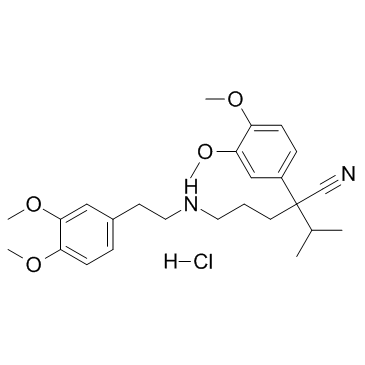Norverapamil hydrochloride ((±)-Norverapamil hydrochloride) (Synonyms: D 591) |
| Catalog No.GC32518 |
Norverapamil hydrochloride ((±)-Norverapamil hydrochloride) ((±)-Norverapamil hydrochloride ((±)-Norverapamil hydrochloride)), an N-demethylated metabolite of Verapamil, is a L-type calcium channel blocker and a P-glycoprotein (P-gp) function inhibitor.
Products are for research use only. Not for human use. We do not sell to patients.

Cas No.: 67812-42-4
Sample solution is provided at 25 µL, 10mM.
Norverapamil is a calcium channel blocker, it is the main active metabolite of verapamil.In vitro: Norverapamil is similarly effective as verapamil at inhibiting isoniazid and rifampicin tolerance and killing of intracellular M. tuberculosis in the absence of other drugs. norverapamil, also inhibits macrophage-induced tolerance and achieves similar serum levels to verapamil.[1] Norverapamil (NOR) is the major metabolite and shows approximately 20% of the efficacy of VER with regard to the vasodilation effect, but shows no antiarrhythmic activity. [2] Verapamil and its major metabolite norverapamil were identified to be both mechanism-based inhibitors and substrates of CYP3A and reported to have non-linear pharmacokinetics in clinic. [3]
[1]. Adams KN et al. Verapamil, and its metabolite norverapamil, inhibit macrophage-induced, bacterial efflux pump-mediated tolerance to multiple anti-tubercular drugs. J Infect Dis. 2014 Aug 1;210(3):456-66. [2]. Singhal P et al. Enantiomeric separation of verapamil and its active metabolite, norverapamil, and simultaneous quantification in human plasma by LC-ESI-MS-MS. J Chromatogr Sci. 2012 Oct;50(9):839-48. [3]. Wang J et al. A semi-physiologically-based pharmacokinetic model characterizing mechanism-based auto-inhibition to predict stereoselective pharmacokinetics of verapamil and its metabolite norverapamil in human. Eur J Pharm Sci. 2013 Nov 20;50(3-4):290-302.
Average Rating: 5 (Based on Reviews and 8 reference(s) in Google Scholar.)
GLPBIO products are for RESEARCH USE ONLY. Please make sure your review or question is research based.
Required fields are marked with *




















